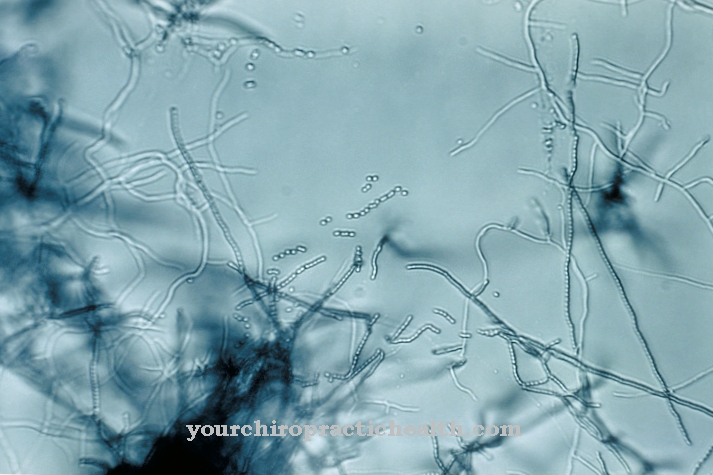Diplococci are bacteria that appear as paired spheres under the microscope. They belong to the streptococcal family and can cause various diseases in humans.
What are diplococci?
Diplococci are a form of cocci. Cocci, in turn, are spherical bacteria that can be completely round or ovoid. Cocci can be recognized in medical terminology by the ending "coccus". For example, there are the bacteria Enterococcus, Streptococcus or Staphylococcus.
If cocci do not separate after cell division, different organizational patterns can arise. This allows a distinction to be made between packet cocci, streptococci, chain cocci, staphylococci and diplococci. While streptococci are stored in chains, diplococci lie together in pairs. Depending on the classification, diplococci are also counted among the streptococci. This is explained by the fact that the paired diplococci are a chain with two links.
Diplococci include, for example, pneumococci, meningococci and the bacteria Neisseria gonorrhoeae and Neiserria meningitidis (meningococci). These pathogens can cause diseases in humans. However, there are also so-called non-pathogenic diplococci. Apathogenic bacteria have no disease value for humans.
The individual cocci can be differentiated on the basis of their coloring behavior in the Gram stain. There are both gram-positive and gram-negative diplococci. While the pathogen Streptococcus pneumoniae (pneumococci) belongs to the gram-positive diplococci, Neisseria are gram-negative diplococci.
Occurrence, Distribution & Properties
The different diplococci are distributed differently. Humans are the pathogen reservoir for the Neisseria gonorrhoeae bacterium. The pathogen is transmitted through sexual intercourse or during childbirth. Neisseria meningitidis live intracellularly and preferentially colonize the pharynx and nose in humans. The pathogen is found in this area in around 10 percent of the European population. The bacteria can be transmitted from person to person via droplet infection. Kissing is a possible source of infection.
Meningococci have small processes, also called pili, with which they can adhere to the mucous membrane of the nasopharynx for weeks or months. When the immune system is weakened, they multiply, penetrate the mucous membranes and get into the blood. The pneumococci also feel good in the area of the mucous membranes of the nose and throat. Although they can be passed on from person to person through droplet infection, infections are usually caused endogenously. This means that pneumococcal infections usually develop from bacteria that are already present in the body. The main carriers and vectors of the pneumococci are children aged one or two years. While adults are hardly carriers of the bacteria, the colonization increases again with increasing age. In people over 65 years of age there are again quite a few pneumococci in the body.
You can find your medication here
➔ Medicines to strengthen the defense and immune systemIllnesses & ailments
Colonization with pneumococci is usually symptom-free. The infestation may be expressed as a slight infection. However, the pathogens weaken the immune system, so that the likelihood of additional viral infections increases. However, especially in old age and with a weak immune system, the bacteria can spread in the body. The result is inflammation of the middle ear, the paranasal sinuses, the lungs or the meninges.
Penumococci are classic pathogens of lobar pneumonia. This is accompanied by fever, pain and difficulty breathing. The ulcus serpens corneae, a cornea ulcer in the eye, can also be caused by the pathogen. If the bacterium spreads in the blood, life-threatening sepsis occurs.
The bacterium Neisseria meningitidis is the causative agent of bacterial meningitis (meningitis). This develops preferentially in children, adolescents, the elderly and immunocompromised patients. The main symptom of meningitis is a very severe headache. These are often accompanied by a stiff neck. Neck stiffness is also known as meningism in medical terminology. Other symptoms of diplococcal meningitis include photophobia and sensitivity to noise. The classic triad of meningeal inflammation consists of meningism, high fever and impaired consciousness. However, this characteristic triad is only seen in 45 percent of patients.
The bacterium Neisseria gonorrhoeae causes the disease gonorrhea. This infectious disease is also known colloquially as gonorrhea. In men, gonococcal infection can lead to inflammation of the prostate. This prostatitis manifests itself as pain when urinating, frequent urination with a small amount of urine, blood in the urine, pain when defecating, pain when ejaculating and a feeling of tightness in the perineum. Depending on the severity of the inflammation, acute urinary retention can occur, in which the patient can no longer urinate. In addition to the prostate, the epididymis is also often affected by the inflammation. Inflammation of the epididymis is called epididymitis. It leads to a severe and painful enlargement of the epididymis.
When infected with Neisseria gonorrhoeae, women develop inflammation of the pelvis and fallopian tubes. Inflammation of the fallopian tubes, also called salpingitis, manifests itself as abdominal pain. These intensify both when urinating and when ovulating. Depending on the severity of the inflammation, fever and vaginal discharge can also occur.
Purulent inflammation of the conjunctiva may develop in newborn babies who become infected during childbirth. This is also known as ophthalmia neonatorum. To prevent this unpleasant condition, which can lead to blindness, mothers with a gonococcal infection are given prophylactic medication to protect the child during delivery.



.jpg)













.jpg)



.jpg)

.jpg)




